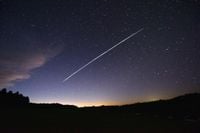Step outside on a clear night in 2025, and you might catch a glimpse of something extraordinary: a streak of light, not from a meteor, but from a Starlink satellite burning up as it reenters Earth’s atmosphere. According to space trackers and astronomers, these cosmic light shows are becoming a daily occurrence—sometimes more than once a day—and they’re a direct result of the satellite gold rush playing out above our heads.
SpaceX, the company helmed by Elon Musk, has been at the forefront of this orbital revolution. In 2025 alone, SpaceX launched over 2,000 Starlink satellites, pushing its total to around 8,000 operational satellites in low Earth orbit (LEO), as reported by Tom’s Hardware. The company’s goal is nothing short of global internet coverage, but the rapid pace comes with a catch: each Starlink satellite is built for a five-year lifespan, after which it’s deliberately deorbited and left to burn up in the atmosphere.
Jonathan McDowell, an astronomer at the Harvard–Smithsonian Center for Astrophysics, has been closely monitoring this phenomenon. In an interview with EarthSky, McDowell stated, “an average of between one to two Starlink satellites deorbiting each day in 2025.” He warned that this number could soon rise to around five per day as SpaceX continues to expand its network and competitors like Amazon’s Project Kuiper ramp up their own mega-constellation plans. “It’s getting pretty busy up there,” McDowell told EarthSky, echoing the growing concerns about orbital congestion.
And it’s not just SpaceX. Amazon, through Project Kuiper, and other firms have announced intentions to add tens of thousands of satellites to the mix. According to GadgetReview, the combined plans of these companies could see 30,000 satellites in LEO, with another 20,000 in higher orbits. Meanwhile, China and other nations are joining the fray, each aiming to establish independent communications systems in space. One Chinese company has already launched over 100 satellites, with many more on the horizon.
All this activity is starting to look like a cosmic traffic jam. The risk isn’t just limited to the satellites themselves; there are about a million centimeter-sized fragments of untracked debris whizzing around in similar orbits, according to Tom’s Hardware. The more crowded the skies become, the higher the chance of collisions—a scenario scientists call Kessler syndrome. First described in the 1970s by NASA scientist Don Kessler, this chain reaction of collisions could eventually render certain orbits unusable, trapping valuable real estate in a cloud of hazardous junk.
The consequences of all this are not purely theoretical. In late September 2025, social media lit up with videos showing Starlink satellites burning up as they fell toward Earth, including a widely shared clip of debris streaking across the California sky. These incidents have sparked public concern about the risks posed by falling satellites and the growing population of space junk.
But how dangerous are these reentries, really? McDowell and other experts emphasize that Starlink satellites are designed to burn up entirely during atmospheric reentry, leaving little to no debris to reach the ground. “Starlink satellites are purposefully designed to burn up entirely in the Earth's atmosphere, posing no danger to people on the ground,” McDowell told EarthSky. The break-up and burning typically occur about 40 miles above the surface—four times higher than a commercial jet flies and at much greater speeds. While there’s a slim chance that a small piece might survive the descent, the risk to people on the ground remains extremely low, at least for now.
However, not all space hardware is created equal. McDowell cautioned that “other uncontrolled space hardware re-entering the atmosphere could pose a significant threat if pieces reach the ground.” Some recent examples from China, where large rocket stages have made uncontrolled reentries, have drawn criticism and highlighted the need for international standards and cooperation.
The Federal Aviation Administration (FAA) is taking these threats seriously. A 2023 FAA report calculated a 61 percent chance of annual ground casualties from satellite debris by 2035 if current deployment trends continue. That’s a sobering statistic—one that suggests the risks will only grow as more satellites are launched and more hardware eventually returns to Earth. McDowell projects that we could soon see five satellites reentering the atmosphere every day, turning what was once a rare event into a routine hazard.
There’s another dimension to the problem: the environment. Scientists are now investigating the potential impacts of frequent satellite deorbits on the atmosphere, particularly the release of pollutants like aluminum-oxide particles. These substances can contribute to atmospheric warming, raising questions about the long-term effects of our growing reliance on satellite technology.
The commercial logic behind the constant churn is clear. Satellites have a median operational life of about five years, after which they’re retired and their orbits are lowered until atmospheric drag does the rest. This planned obsolescence keeps networks fresh and functional but also ensures a steady stream of reentries. As McDowell explained to Tom’s Hardware, “a commercial satellite will work as intended for a median of about five years. Then they are retired, and their orbits are lowered. Eventually, the atmosphere drags them in the rest of the way, before they re-enter at an unpredictable location.”
For the average person, these developments might seem distant or abstract—until a fiery streak appears in the night sky or concerns about falling debris make headlines. Some have even joked that daily satellite reentries could soon be as routine as checking the weather before heading out for a jog. But the underlying issues are no laughing matter. The satellite boom that powers our internet connections and global communications is also creating a new set of challenges for regulators, scientists, and the public.
Calls for global regulation and coordination are growing louder. McDowell, among others, has advocated for international agreements to manage satellite deployments and ensure that all players—corporate and national—follow best practices for safety and sustainability. As he put it, “we need some kind of global regulation and coordination to keep us Earth dwellers safe.”
With tens of thousands of new satellites on the way and the risks of Kessler syndrome and environmental impacts looming, the world is facing a critical moment in the management of outer space. The choices made now will determine whether the skies above remain a resource for all or become a hazardous dumping ground for discarded technology.
For now, the spectacle of burning satellites is a reminder that our ambitions in space come with real-world consequences. As the number of satellites—and the risks—continue to climb, the need for thoughtful stewardship of the final frontier has never been clearer.


